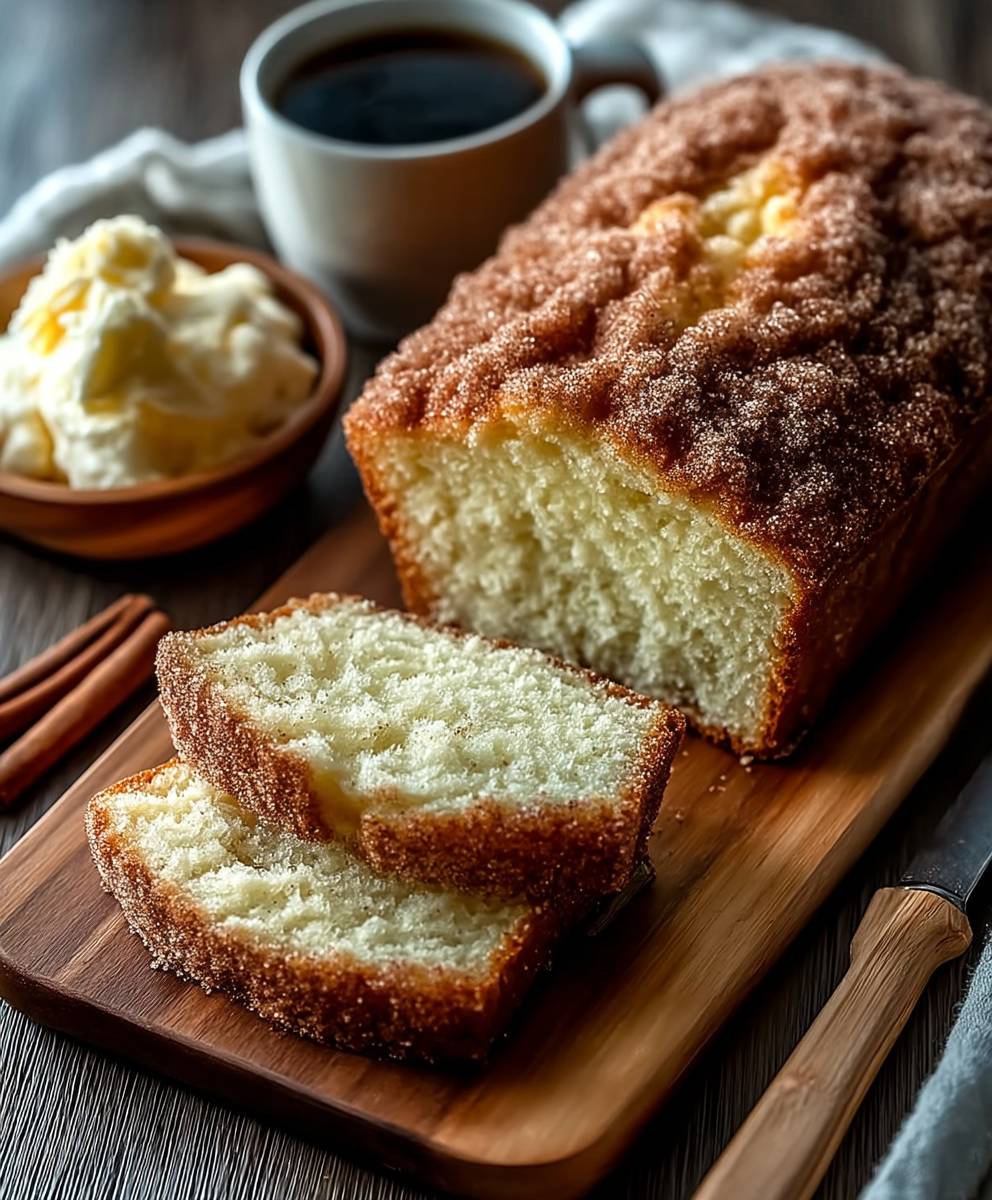Cinnamon Donut Bread: Prepare to be amazed! Imagine the warm, comforting flavors of a freshly baked cinnamon donut, but in the form of a soft, sliceable bread. Yes, you read that right! This isn’t just any bread; it’s a delightful fusion of two beloved treats, creating a breakfast or dessert experience that’s utterly irresistible.
While the exact origins of cinnamon donut bread are a bit of a modern mystery, its inspiration is clear. Cinnamon donuts themselves have a long and delicious history, evolving from simple fried dough to the sugary, spiced rings we adore today. This bread takes that classic flavor profile and elevates it to a new level of comfort food.
What makes this bread so special? It’s the perfect combination of textures – a tender crumb with a slightly crisp, cinnamon-sugar crust. The aroma alone is enough to make your mouth water! Plus, it’s incredibly versatile. Enjoy it warm with a pat of butter, use it for French toast, or even grill it for a decadent sandwich. It’s a guaranteed crowd-pleaser that’s surprisingly easy to make, bringing the joy of donuts to your table in a whole new way. Get ready to bake up a batch of happiness!
Ingredients:
- For the Dough:
- 3 cups all-purpose flour, plus more for dusting
- 1/4 cup granulated sugar
- 1 teaspoon salt
- 1 packet (2 1/4 teaspoons) active dry yeast
- 1 cup warm milk (105-115°F)
- 1/4 cup unsalted butter, melted
- 1 large egg
- 1 teaspoon vanilla extract
- For the Cinnamon Sugar Coating:
- 1 cup granulated sugar
- 2 tablespoons ground cinnamon
- 1/2 cup unsalted butter, melted
- For the Glaze (Optional):
- 2 cups powdered sugar
- 1/4 cup milk
- 1/2 teaspoon vanilla extract
Preparing the Dough:
- Combine Dry Ingredients: In a large bowl, whisk together the flour, sugar, and salt. This ensures the sugar and salt are evenly distributed throughout the flour, which is crucial for proper yeast activation and flavor.
- Activate the Yeast: In a separate bowl, dissolve the yeast in the warm milk. Let it stand for 5-10 minutes, or until foamy. This step is important to make sure your yeast is alive and active. If it doesn’t foam, your yeast might be old, and you’ll need to get a fresh packet.
- Combine Wet and Dry Ingredients: Add the melted butter, egg, and vanilla extract to the yeast mixture. Whisk to combine. Pour the wet ingredients into the dry ingredients and stir with a wooden spoon or spatula until a shaggy dough forms.
- Knead the Dough: Turn the dough out onto a lightly floured surface. Knead for 8-10 minutes, or until the dough is smooth and elastic. You can also use a stand mixer with a dough hook attachment. The dough should be slightly tacky but not sticky. If it’s too sticky, add a tablespoon of flour at a time until it reaches the right consistency. Proper kneading develops the gluten, which gives the bread its structure and chewiness.
- First Rise: Place the dough in a lightly oiled bowl, turning to coat. Cover with plastic wrap or a clean kitchen towel and let rise in a warm place for 1-1.5 hours, or until doubled in size. The warmer the environment, the faster the dough will rise. You can place it in a slightly warmed oven (turned off!) or near a sunny window.
Shaping the Bread:
- Punch Down the Dough: Gently punch down the dough to release the air. This helps to redistribute the yeast and create a more even texture.
- Divide the Dough: Turn the dough out onto a lightly floured surface and divide it into 12-15 equal pieces. I usually aim for 12, but you can adjust based on how large you want your bread pieces to be.
- Roll into Balls: Roll each piece of dough into a smooth ball. Try to make them as uniform as possible for even baking.
- Arrange in a Pan: Grease a 9×13 inch baking pan. Arrange the dough balls evenly in the pan, leaving a little space between each one. They will expand during the second rise.
Second Rise and Baking:
- Second Rise: Cover the pan with plastic wrap or a clean kitchen towel and let rise in a warm place for 30-45 minutes, or until the dough balls have puffed up and are almost touching. This second rise is crucial for a light and airy bread.
- Preheat Oven: Preheat oven to 350°F (175°C). Make sure your oven is properly preheated before baking to ensure even cooking.
- Bake: Bake for 25-30 minutes, or until the bread is golden brown on top. If the top starts to brown too quickly, you can tent it with foil.
- Cool Slightly: Let the bread cool in the pan for 5-10 minutes before transferring it to a wire rack to cool completely. This prevents the bread from becoming soggy.
Preparing the Cinnamon Sugar Coating:
- Combine Sugar and Cinnamon: In a shallow bowl, combine the granulated sugar and ground cinnamon. Mix well.
- Melt Butter: Melt the unsalted butter in a separate bowl.
- Dip and Coat: While the bread is still warm (but not too hot to handle), dip each dough ball into the melted butter, then immediately roll it in the cinnamon sugar mixture, ensuring it’s fully coated. I find that using two forks helps with this process.
Preparing the Glaze (Optional):
- Whisk Ingredients: In a medium bowl, whisk together the powdered sugar, milk, and vanilla extract until smooth. Add more milk, one tablespoon at a time, if needed to reach your desired consistency. The glaze should be pourable but not too thin.
- Drizzle Glaze: Once the bread has cooled slightly, drizzle the glaze over the top. You can use a spoon or a piping bag for a more precise application.
Serving and Storage:
Serve the cinnamon donut bread warm or at room temperature. It’s best enjoyed fresh, but you can store leftovers in an airtight container at room temperature for up to 2 days. If you want to reheat it, you can microwave it for a few seconds or warm it in the oven at a low temperature.
Tips for Success:
- Use a Thermometer: Ensure your milk is between 105-115°F for optimal yeast activation. Too hot, and you’ll kill the yeast; too cold, and it won’t activate properly.
- Don’t Over-Knead: Over-kneading can result in a tough bread. Knead until the dough is smooth and elastic, but not overly firm.
- Warm Environment for Rising: A warm, draft-free environment is crucial for proper rising. If your kitchen is cold, try placing the dough in a slightly warmed oven (turned off) or near a sunny window.
- Adjust Sweetness: If you prefer a less sweet bread, you can reduce the amount of sugar in the dough or the cinnamon sugar coating.
- Add Spices: Feel free to add other spices to the cinnamon sugar mixture, such as nutmeg or cardamom, for a more complex flavor.
- Variations: You can add chopped nuts, raisins, or chocolate chips to the dough for added texture and flavor.
Conclusion:
This Cinnamon Donut Bread isn’t just another recipe; it’s a warm hug on a plate, a nostalgic trip to your favorite bakery, and a guaranteed crowd-pleaser all rolled into one delicious loaf. I truly believe this is a must-try recipe for anyone who loves the comforting flavors of cinnamon and the satisfying texture of a perfectly baked bread. The ease of preparation combined with the incredible taste makes it a winner in my book, and I’m confident it will be in yours too.
Think about it: the soft, tender crumb, the sweet cinnamon swirl that runs through every slice, and that irresistible glaze that adds the perfect touch of sweetness. It’s like having a whole batch of cinnamon donuts without all the fuss of frying! This bread is perfect for a weekend brunch, a cozy afternoon treat, or even a delightful dessert after dinner. It’s versatile, adaptable, and utterly addictive.
But the best part? You can easily customize this recipe to suit your own preferences. For a richer flavor, try using brown butter in the batter. The nutty notes of brown butter will complement the cinnamon beautifully. If you’re feeling adventurous, add a handful of chopped pecans or walnuts to the batter for a delightful crunch. Or, for a truly decadent experience, drizzle the finished loaf with a chocolate ganache instead of the traditional glaze.
Serving suggestions are endless! A warm slice of this Cinnamon Donut Bread is divine on its own, but it’s also fantastic toasted and served with a dollop of whipped cream or a scoop of vanilla ice cream. You could even use it to make French toast for an extra special breakfast treat. Imagine dipping slices of this cinnamon-swirled goodness into a custard batter and frying it until golden brown – pure heaven!
And don’t forget about gifting! This bread makes a wonderful present for friends, family, or neighbors. Wrap it in cellophane, tie it with a ribbon, and you’ve got a thoughtful and delicious gift that’s sure to be appreciated. I’ve personally gifted this bread countless times, and it’s always a hit.
I’ve poured my heart into perfecting this recipe, and I’m so excited for you to try it. I truly believe that this Cinnamon Donut Bread will become a staple in your baking repertoire. It’s simple enough for beginner bakers, yet impressive enough to serve to guests.
So, what are you waiting for? Gather your ingredients, preheat your oven, and get ready to bake up a batch of this incredible bread. I promise you won’t be disappointed. And most importantly, don’t forget to share your experience with me! I’d love to hear how your bread turned out, what variations you tried, and what your family and friends thought of it. Leave a comment below, tag me on social media, or send me an email. I can’t wait to see your creations! Happy baking! I am confident that this Cinnamon Donut Bread will become a family favorite.
Cinnamon Donut Bread: The Ultimate Guide to Baking Deliciousness
Soft and fluffy cinnamon donut bread made from scratch, perfect for breakfast or dessert. Each dough ball is coated in cinnamon sugar and drizzled with a sweet glaze.
Ingredients
Instructions
Recipe Notes
- Use a thermometer to ensure your milk is between 105-115°F for optimal yeast activation.
- Don’t over-knead the dough.
- A warm, draft-free environment is crucial for proper rising.
- Adjust sweetness to your preference.
- Add spices like nutmeg or cardamom to the cinnamon sugar mixture.
- Add chopped nuts, raisins, or chocolate chips to the dough.
- Serve warm or at room temperature.
- Store leftovers in an airtight container at room temperature for up to 2 days.
- Reheat in the microwave or oven.






Leave a Comment